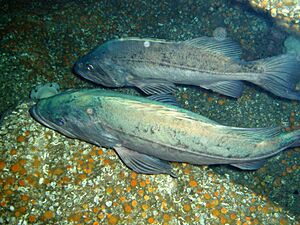Bocaccio rockfish facts for kids
Quick facts for kids Bocaccio rockfish |
|
|---|---|
 |
|
| Courtesy of the Monterey Bay Aquarium | |
| Conservation status | |
| Scientific classification | |
| Synonyms | |
|
The bocaccio rockfish (Sebastes paucispinis) is a type of fish that lives in the ocean. It's a ray-finned fish, which means it has fins supported by bony rays. You can find these fish in the northeast Pacific Ocean. They are part of a group called rockfishes.
Contents
About Their Name
Scientists give every living thing a special name. The bocaccio rockfish was first officially described in 1854. An American scientist named William Orville Ayres gave it its name.
The name paucispinis comes from two Latin words. Paucis means "few" or "poor." Spinus means "spine." This name refers to the fact that the bocaccio has fewer and weaker spines on its head. This is compared to another fish, the China rockfish, which Ayres also described.
Where Bocaccio Live and How They Grow
Bocaccio rockfish live in the ocean from Alaska all the way down to Baja California. They are most common from Oregon to northern Baja California. These fish can be found at many different depths. Some live near the surface, while others live as deep as 1,568 feet (478 meters). Most bocaccio live between 150 and 1,000 feet (46 to 305 meters) deep.
Young Bocaccio
Young bocaccio stay in shallower waters. They use floating kelp mats or driftwood for protection. Shallow water kelp forests and even oil platforms help them hide. These places keep them safe from bigger fish that might want to eat them.
Adult Bocaccio
As bocaccio get older, they move into deeper, colder water. The Monterey submarine canyon is a great home for many ocean animals. Bocaccio in this canyon eat many different things. They enjoy shellfish like shrimp and crab. They also eat anchovies, sardines, other small rockfishes, and squid.
Size and Lifespan
The bocaccio is one of the larger rockfish species. It can grow up to 3 feet (about 1 meter) long. These fish can live for as long as 45 years! A bocaccio that is 12 inches (30 cm) long is usually 3 to 4 years old. A fish that is 2 feet (61 cm) long is about 7 to 8 years old.
Female bocaccio grow faster than males. They also tend to live longer.
Reproduction
Bocaccio rockfish give birth to live young, just like mammals. This is called being viviparous. In Southern California, females release their larvae (baby fish) in two or more groups. They can do this almost all year long. In Central and Northern California, they usually spawn from January to May. Further north, they spawn from January to March. One female bocaccio can produce over 2 million eggs in a single season!
Appearance
Bocaccio rockfish are olive-brown on their backs. Their color changes to pink or red on their bellies.
How the Environment Affects Bocaccio
The ocean environment plays a big role in the lives of bocaccio. One important process is called upwelling. This is when cold, nutrient-rich water from the deep ocean rises to the surface. This cold water brings lots of food for tiny ocean plants.
Upwelling and Food
When upwelling is strong, the water is cold, and there's plenty of food. This helps the bocaccio and their larvae. If upwelling is weak, the water is warmer, and there isn't as much food. This can affect how many eggs a female produces and how healthy they are.
Ocean Changes
Big ocean weather patterns like El Niño and La Niña also affect upwelling. These patterns cause big changes in ocean water temperature. These changes can impact the food supply for bocaccio.
Protecting Bocaccio Rockfish
People fish for bocaccio rockfish for fun and for business. They are caught using nets, lines, and hooks. Unfortunately, too many bocaccio have been caught in recent years. This is called overfishing. Commercial fishermen often target bocaccio because there are many of them, and they stay fresh for a long time.
Oil Platforms and Young Fish
Studies have shown that oil platforms off Southern California can actually help bocaccio. Young bocaccio like to use these platforms. The platforms are like natural habitats, offering protection and plenty of plankton (tiny organisms) to eat. One study found many young bocaccio living around seven out of eight platforms.
Conservation Efforts
Because of concerns about their numbers, the U.S. National Marine Fisheries Service (NMFS) has looked into protecting bocaccio. In 2001, they received a request to list the southern population as a threatened species. However, in 2002, they decided it wasn't needed at that time.
The southern population of bocaccio is considered a "Species of Concern." This means the U.S. government is worried about their status. They are watching them closely, but there isn't enough information yet to list them as endangered.
However, a different population of bocaccio, the Puget Sound/Georgia basin group, was listed as endangered in 2010. This means they are at high risk of disappearing. Areas important for their survival were officially protected in 2014.


